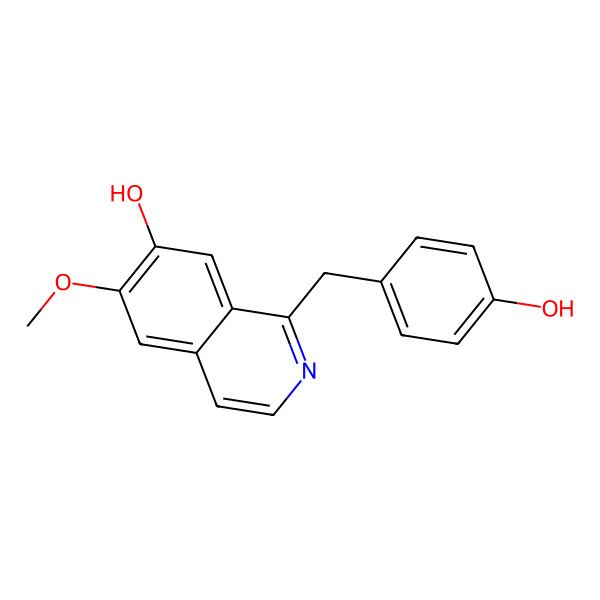Juzirine
| Internal ID | 3bef5fb1-e7f6-4f38-940a-ed630ccaf42e |
| Taxonomy | Organoheterocyclic compounds > Isoquinolines and derivatives > Benzylisoquinolines |
| IUPAC Name | 1-[(4-hydroxyphenyl)methyl]-6-methoxyisoquinolin-7-ol |
| SMILES (Canonical) | COC1=C(C=C2C(=C1)C=CN=C2CC3=CC=C(C=C3)O)O |
| SMILES (Isomeric) | COC1=C(C=C2C(=C1)C=CN=C2CC3=CC=C(C=C3)O)O |
| InChI | InChI=1S/C17H15NO3/c1-21-17-9-12-6-7-18-15(14(12)10-16(17)20)8-11-2-4-13(19)5-3-11/h2-7,9-10,19-20H,8H2,1H3 |
| InChI Key | XUCRLUHFLBPVRO-UHFFFAOYSA-N |
| Popularity | 7 references in papers |
| Molecular Formula | C17H15NO3 |
| Molecular Weight | 281.30 g/mol |
| Exact Mass | 281.10519334 g/mol |
| Topological Polar Surface Area (TPSA) | 62.60 Ų |
| XlogP | 3.30 |
| 64069-53-0 |
| 1-[(4-hydroxyphenyl)methyl]-6-methoxyisoquinolin-7-ol |
| HYS6BR39QH |
| 1-((4-Hydroxyphenyl)methyl)-6-methoxy-7-isoquinolinol |
| 7-Isoquinolinol, 1-((4-hydroxyphenyl)methyl)-6-methoxy- |
| Yuzirine |
| UNII-HYS6BR39QH |
| DTXSID20214263 |
| CHEBI:179577 |
| AKOS040752214 |
| There are more than 10 synonyms. If you wish to see them all click here. |

| Target | Value | Probability (raw) | Probability (%) |
|---|---|---|---|
| No predicted properties yet! | |||
Proven Targets:
| CHEMBL ID | UniProt ID | Name | Min activity | Assay type | Source |
|---|---|---|---|---|---|
| No proven targets yet! | |||||
Predicted Targets (via Super-PRED):
| CHEMBL ID | UniProt ID | Name | Probability | Model accuracy |
|---|---|---|---|---|
| CHEMBL3091268 | Q92753 | Nuclear receptor ROR-beta | 95.57% | 95.50% |
| CHEMBL2635 | P51452 | Dual specificity protein phosphatase 3 | 95.49% | 94.00% |
| CHEMBL2107 | P61073 | C-X-C chemokine receptor type 4 | 95.04% | 93.10% |
| CHEMBL3251 | P19838 | Nuclear factor NF-kappa-B p105 subunit | 94.38% | 96.09% |
| CHEMBL5619 | P27695 | DNA-(apurinic or apyrimidinic site) lyase | 93.54% | 91.11% |
| CHEMBL1951 | P21397 | Monoamine oxidase A | 93.44% | 91.49% |
| CHEMBL3060 | Q9Y345 | Glycine transporter 2 | 93.19% | 99.17% |
| CHEMBL2535 | P11166 | Glucose transporter | 92.55% | 98.75% |
| CHEMBL1293249 | Q13887 | Kruppel-like factor 5 | 92.00% | 86.33% |
| CHEMBL5747 | Q92793 | CREB-binding protein | 91.39% | 95.12% |
| CHEMBL1860 | P10827 | Thyroid hormone receptor alpha | 90.35% | 99.15% |
| CHEMBL2581 | P07339 | Cathepsin D | 88.22% | 98.95% |
| CHEMBL241 | Q14432 | Phosphodiesterase 3A | 86.85% | 92.94% |
| CHEMBL1255126 | O15151 | Protein Mdm4 | 85.54% | 90.20% |
| CHEMBL4203 | Q9HAZ1 | Dual specificity protein kinase CLK4 | 85.52% | 94.45% |
| CHEMBL225 | P28335 | Serotonin 2c (5-HT2c) receptor | 84.29% | 89.62% |
| CHEMBL4208 | P20618 | Proteasome component C5 | 83.75% | 90.00% |
| CHEMBL4261 | Q16665 | Hypoxia-inducible factor 1 alpha | 83.21% | 85.14% |
| CHEMBL5339 | Q5NUL3 | G-protein coupled receptor 120 | 81.21% | 95.78% |
| CHEMBL6175 | Q9H3R0 | Lysine-specific demethylase 4C | 81.09% | 96.69% |
| CHEMBL4306 | P22460 | Voltage-gated potassium channel subunit Kv1.5 | 80.42% | 94.03% |
Below are displayed all the plants proven (via scientific papers) to contain this
compound!
To see more specific details click the taxa you are interested in.
To see more specific details click the taxa you are interested in.
| Xylopia parviflora |
| Ziziphus jujuba var. spinosa |
| PubChem | 3085285 |
| LOTUS | LTS0072132 |
| wikiData | Q83090078 |